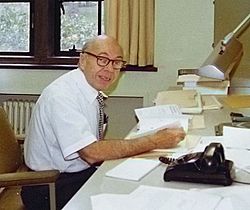Ugo Fano facts for kids
Quick facts for kids
Ugo Fano
|
|
|---|---|

Fano in 1978
|
|
| Born | July 28, 1912 |
| Died | February 13, 2001 (aged 88) |
| Nationality | American |
| Alma mater | University of Turin |
| Known for | Lu–Fano plot Feshbach–Fano partitioning Fano resonance Fano factor Fano effect Fano–Lichten mechanism Beutler-Fano profile Fano noise |
| Awards | Enrico Fermi Award (1995) William F. Meggers Award (1989) ( Davisson–Germer Prize (1976) Fellow of the Royal Society |
| Scientific career | |
| Fields | Physicist and Biophysicist |
| Institutions | University of Chicago Carnegie Institute National Institute of Standards and Technology University of Rome University of Leipzig |
| Doctoral advisor | Enrico Persico |
| Other academic advisors | Enrico Fermi Werner Heisenberg |
| Doctoral students | Chris H. Greene |
| Influences | Giulio Racah Emilio G. Segrè Salvatore Luria |
| Notes | |
|
His father was Gino Fano, he is the brother of Robert Fano, and the cousin of Giulio Racah.
|
|
Ugo Fano (born July 28, 1912 – died February 13, 2001) was an Italian American scientist. He was a brilliant physicist who made many important discoveries. His work helped us understand how tiny particles like atoms and molecules behave.
Contents
About Ugo Fano
Ugo Fano grew up in a wealthy Jewish family in Turin, Italy. His father, Gino Fano, was a math professor.
His Education
Ugo loved learning. He earned his PhD in mathematics in 1934 from the University of Turin. His main project was about how to calculate energy levels in atoms using quantum mechanics.
Early Work in Europe
Fano worked with a famous scientist named Enrico Fermi in Rome. He was part of a group of young scientists known as the 'Via Panisperna boys'. During this time, Fermi encouraged Fano to develop a new idea. This idea was about how particles interact in a special way, leading to what is now called the Fano resonance. His papers on this topic became very important in physics.
From 1936 to 1937, Fano also worked with another great physicist, Werner Heisenberg, in Germany.
Moving to the United States
In 1939, Ugo Fano married Camilla Lattes, also known as Lilla. She was a teacher and later helped him write a well-known book. This book, Physics of Atoms and Molecules, explained how atoms and molecules work.
Later in 1939, Fano moved to the United States. He left Italy because of new laws that were unfair to Jewish people. In the U.S., he first studied tiny living things called bacteriophages. He also did important early work in radiological physics. This field looks at how radiation, like X-rays, affects living things.
During World War II, he worked at a military testing ground. After the war, he joined the National Bureau of Standards (NBS). This is now called the National Institute of Standards and Technology (NIST). He was the first theoretical physicist hired there.
In 1966, he became a professor at the University of Chicago. He taught and guided many students there until the early 1990s. Many of his students became leaders in atomic and molecular physics around the world.
His Scientific Discoveries
Ugo Fano made a huge impact on the study of atomic physics and molecular physics. These fields look at how atoms and molecules behave. He also contributed to radiological physics, which studies radiation.
Many important ideas and effects in physics are named after him. These include the Fano resonance, the Fano factor, and the Fano effect. These discoveries are still used in research today.
His Family Connections
Ugo Fano's brother, Robert Fano, was also a famous professor. He taught electrical engineering at MIT. Ugo's cousin, Giulio Racah, made big contributions to quantum theory. They even wrote a book together about how particles spin.
Awards and Recognition
Ugo Fano was a member of important science groups. These included the United States National Academy of Sciences and the Royal Society of London.
He received the William F. Meggers Award in 1989 for his work in spectroscopy. This is the study of how light interacts with matter.
In 1995, he was given the Enrico Fermi Award. This is one of the highest honors for scientists in the U.S. His paper from 1961, about the Fano resonance, is one of his most famous works.

